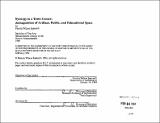| dc.contributor.advisor | Rosemary Grimshaw. | en_US |
| dc.contributor.author | Sartorelli, Pamela Wilson | en_US |
| dc.contributor.other | Massachusetts Institute of Technology. Dept. of Architecture. | en_US |
| dc.coverage.spatial | n-usn-- | en_US |
| dc.date.accessioned | 2012-04-26T18:25:56Z | |
| dc.date.available | 2012-04-26T18:25:56Z | |
| dc.date.copyright | 1994 | en_US |
| dc.date.issued | 1994 | en_US |
| dc.identifier.uri | http://hdl.handle.net/1721.1/70238 | |
| dc.description | Thesis (M. Arch.)--Massachusetts Institute of Technology, Dept. of Architecture, 1994. | en_US |
| dc.description | Includes bibliographical references (p. 165-166). | en_US |
| dc.description.abstract | This thesis proposes a new model for public and educational space in a synergistic and physical relationship that encourages interaction and change. This model provides an arena for redefinition and mutual transformation of the concepts of public and education through time. The exploration of how these spaces or territories can respond to the changing needs of a community engages the question of how an architectural design response can include the opportunity for change to occur. The proposed design response to change travels two paths. First, the concept of overlap between the space of the public and the educational is explored in shared movement and use patterns that are intensified by alternating layers of transparency and opacity that build the space of interaction. Second, this thesis investigates the representation of time in the architectural artifact. Using the artifact as an element within the formal language of an architectural proposal offers a relationship between old and new that renders the element of time as part of an ongoing continuum. The participation of the artifact within a current formal dialogue is an opportunity to draw the past to the present in ways that welcome and encourage ongoing change. The design component of this investigation places programs of community college and civic town center within the environs of a New England textile mill and village. The identification of the artifact, from the ruins of the mill, defines the space of the town center and college that is inclusive of the community, region and river environment. Just as the child resembles the grandparent and recalls his embrace, the shadow is there; the cast remembers the mold. Similarly, the architectural artifact is a symbolic embrace -- a continuity in the transformation and redefinition of public and educational space. It is from the shoulders of giants that we can see better the place of our community. | en_US |
| dc.description.statementofresponsibility | by Pamela Wilson Sartorelli. | en_US |
| dc.format.extent | 166 p. (some folded) | en_US |
| dc.language.iso | eng | en_US |
| dc.publisher | Massachusetts Institute of Technology | en_US |
| dc.rights | M.I.T. theses are protected by
copyright. They may be viewed from this source for any purpose, but
reproduction or distribution in any format is prohibited without written
permission. See provided URL for inquiries about permission. | en_US |
| dc.rights.uri | http://dspace.mit.edu/handle/1721.1/7582 | en_US |
| dc.subject | Architecture. | en_US |
| dc.title | Synergy in a town center : juxtaposition of artifact, public, and educational space | en_US |
| dc.title.alternative | Juxtaposition of artifact, public, and educational space | en_US |
| dc.type | Thesis | en_US |
| dc.description.degree | M.Arch. | en_US |
| dc.contributor.department | Massachusetts Institute of Technology. Department of Architecture | |
| dc.identifier.oclc | 30965229 | en_US |
